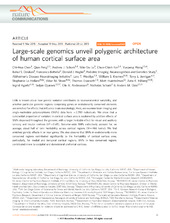Large-scale genomics unveil polygenic architecture of human cortical surface area
Chen, Chi-Hua; Peng, Qian; Schork, Andrew J.; Lo, Min-Tzu; Fan, Chun-Chieh; Wang, Yunpeng; Desikan, Rahul S.; Bettella, Franscesco; Hagler, Donald J.; Westlye, Lars Tjelta; Kremen, William S.; Jernigan, Terry L.; Le Hellard, Stephanie; Steen, Vidar Martin; Espeseth, Thomas; Huentelman, Matt; Håberg, Asta; Agartz, Ingrid; Djurovic, Srdjan; Andreassen, Ole Andreas; Schork, Nicholas; Dale, Anders
Peer reviewed, Journal article
Published version

Åpne
Permanent lenke
https://hdl.handle.net/1956/10843Utgivelsesdato
2015-07-20Metadata
Vis full innførselSamlinger
Originalversjon
https://doi.org/10.1038/ncomms8549Sammendrag
Little is known about how genetic variation contributes to neuroanatomical variability, and whether particular genomic regions comprising genes or evolutionarily conserved elements are enriched for effects that influence brain morphology. Here, we examine brain imaging and single-nucleotide polymorphisms (SNPs) data from ~2,700 individuals. We show that a substantial proportion of variation in cortical surface area is explained by additive effects of SNPs dispersed throughout the genome, with a larger heritable effect for visual and auditory sensory and insular cortices (h2~0.45). Genome-wide SNPs collectively account for, on average, about half of twin heritability across cortical regions (N=466 twins). We find enriched genetic effects in or near genes. We also observe that SNPs in evolutionarily more conserved regions contributed significantly to the heritability of cortical surface area, particularly, for medial and temporal cortical regions. SNPs in less conserved regions contributed more to occipital and dorsolateral prefrontal cortices.
